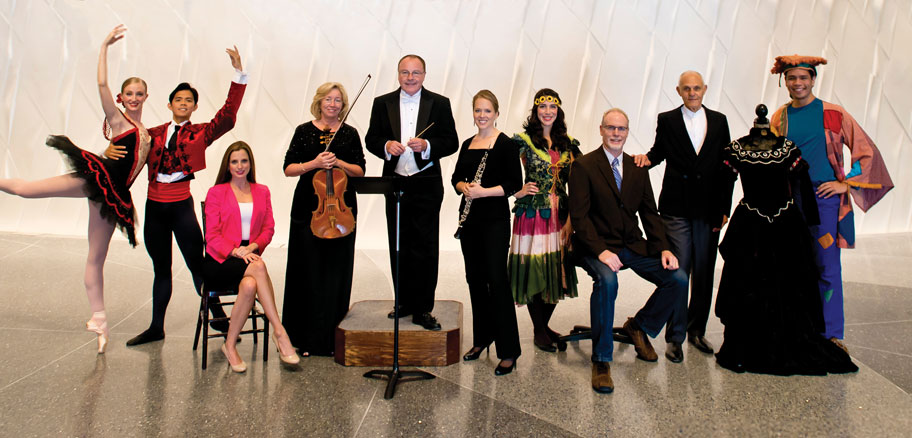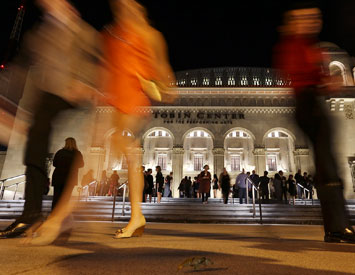The Tobin Connection
The ties between UTSA’s music and performance programs and San Antonio’s arts scene are in the spotlight–and will be made even stronger–with the opening of the city’s premier performing arts venue
On opening night, there were exclamations, nods of approval and a lot of wide eyes as people filtered through the lobby and made their way to their seats for the gala at the Tobin Center for the Performing Arts.
The Sept. 4 event showcased the new $203 million state-of-the-art center as well as three resident companies -- San Antonio Symphony, Ballet San Antonio and Opera San Antonio.
UTSA alumna Courtney Barker ’05, the ballet’s president and executive director, got there early, as is her custom when the company has a performance. “I told the principal dancers to have fun and own it; this is their city and their moment too,” she says. Then, she went out to the lobby to mingle with the patrons, take a deep breath and do her best to relax.
Meanwhile, the members of the San Antonio Symphony prepared for a marathon 90-minute set that at times accompanied the ballet and opera but also included a rousing rendition of “American in Paris.” The night ended with a full-house standing ovation and began a new era of performing arts in the Alamo City.
Veteran strings lecturer Allyson Dawkins, the symphony’s principal violist, says that first performance was “an exciting adventure.” Dawkins started the first year the symphony began and has been teaching at UTSA since 1981. She’s just one example of the university’s shared connections with the Tobin Center.
UTSA faculty, staff and students have long been woven into the city’s performing and creative arts scene. Like Dawkins, professors in the music department are veteran symphony players. About 10 years ago the Tobin Foundation for Theatre Arts donated stage costumes, backdrops and music scores to UTSA from the Metropolitan Opera in New York City. Many of those costumes remain in use today.
With partnerships already formed, faculty and alumni working for the resident companies, and the goal of the College of Liberal and Fine Arts to grow its own performing arts programs, those established relationships will strengthen as new opportunities present themselves. “The long-term ambition is to have a school of performing arts or something similar so that music, opera and dance are all more developed,” says Dan Gelo, who holds the Stumberg Distinguished University Chair for the Dean of Liberal and Fine Arts. “One of our focuses is to be a cultural resource for the community.”
Dawkins has seen the music program explode since she started teaching and says that, along with the strong orchestra, the music department has a “really fantastic success rate” of training music educators.
Recently, the university created a dance minor that within a couple of years is hoped to become a bachelor of fine arts in dance. And UTSA’s Lyric Theater continues to perform musicals and operas throughout the year.
A growing opera presence would be beneficial for both the university and Opera San Antonio, according to leaders of the groups. Opera San Antonio’s chairman, Mel Weingart, and UTSA professor and Lyric Theater director William McCrary have known each other for years. The two helped form Opera to Go, an educational program that takes opera to public schools and is supported by the Lyric Theater and Opera Guild. McCrary says Lyric Theater helps students who want to perform and sing as well as those who want to be teachers. “A lot of our students are getting degrees in music education,” he says, “and they’re going to go on to their jobs and be asked to produce musicals as a music director, or the principal might ask them to actually be in the musical.”
As part of increasing the exposure and education for students, the music department, Lyric Theater, Opera Guild and Opera San Antonio are in early talks to form a young artist program. “It would be a program to enable young talent to participate with this opera company,” Weingart says.
That is a long-term goal, everyone recognizes, but the educational opportunities have already started. On Sept. 25, eight members of the opera company’s Fantastic Mr. Fox production, including the resident conductor, Andres Cladera, visited UTSA’s recital hall. Without costumes or props, they performed short pieces to the accompaniment of pianist Cheryl Cellon-Lindquist. The students then got to ask them questions, the subjects ranging from quelling nerves at an audition to advice for the future. “Get out of your school bubble” was just one piece of advice from tenor Edwin Vega.
And during the preparation for Renée Fleming’s Tobin show, vocal students got to sit in on a dress rehearsal, says Jennifer Berg. In her second year as lecturer in the music department, Berg has been with the symphony since 2012. A San Antonio native, she returned after studying at Indiana University and New England Conservatory. Berg isn’t sure what the opening of the Tobin could mean for students but says, “The symphony has worked with UTSA vocal students in the past... It might afford UTSA students the chance to perform on its stage when we collaborate with them in the future.”
Aaron Zimmerman, the Tobin’s senior director of programming and marketing, says based on his experience working at large venues in Chicago; New York City; Washington, D.C.; and Miami, entertainment availability is “massively important” to the 18-to-25 demographic. “There isn’t a college student that doesn’t mention music or dance or performing arts as some sort of driving force and release in their life. Very soon they’ll be having to decide what’s next and ‘If I’m going to be stuck behind a desk, where am I going to go to enjoy myself?’ and a lot of people say the performing arts.” Plus, he adds, the current fans could become loyal patrons in the future.
Zimmerman says the Tobin Center is currently working on education programs for public schools and, as it gets established, would definitely want to work with local higher education in some fashion.
Not everyone needs to be on the stage. There’s also the lure of the city’s low cost of living and a creative industry that is already present and provides jobs for those interested in working with arts without being an artist. In 2011, San Antonio’s creative industry generated $4.6 billion in economic activity, employing 29,852 workers who earned wages totaling $1.1 billion, according to a 2011 report from the SABER Institute at St. Mary’s University. Public relations specialists are included on that list.
Barker, the director of the ballet, came back to San Antonio after dancing in New York. She graduated with a bachelor’s degree in communication and credited the public relations savvy she learned at UTSA along with her personal knowledge of ballet as a combination that makes for her dream job.
UTSA professor John Silantien, the conductor of the San Antonio Mastersingers says just the presence of a new center -- especially one with such a variety of entertainment -- is a benefit. Like Dawkins, he’s been with the university for more than 30 years and the Master-singers nearly that long as well. He points to other cities that had increased enthusiasm in the arts after a new center opened. “I think any artistic or cultural growth for the city is good for us. When there’s a new concert hall, there’s just a big improvement for visibility in the arts. I think it’s an inevitable and gradual progression for the city.”


